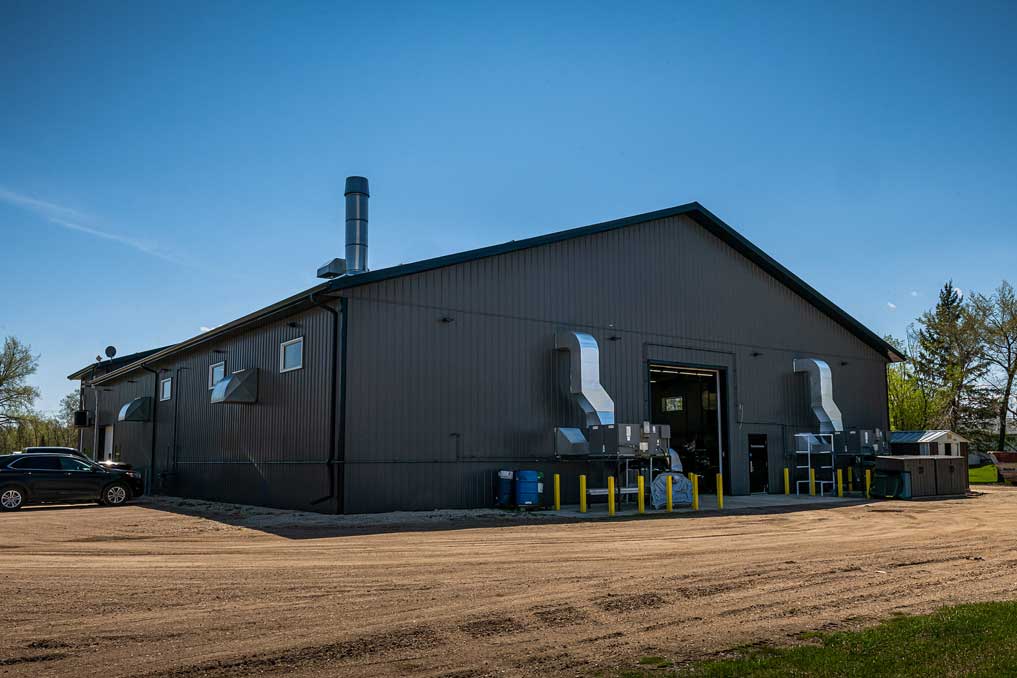
Navigating the terminology of metal buildings can sometimes feel like learning a new language. But whether you’re a seasoned estimator, retailer, contractor or embarking on your first metal building project, understanding the basic components will help you speak confidently with your installer and make informed decisions.
At Westman Steel, we believe in empowering our customers. Let’s dive deeper into the essential parts that make up a robust and reliable metal building, utilizing the high-quality steel products we manufacture right here in Canada.
Key Components of a Westman Steel Building:

Rake: This refers to the angled intersection where the roof slope meets the endwall (the non-eave side) of your building. It’s a crucial line for the aesthetic and structural integrity of the roof system.
Gable Trim: Installed along the rake, or the sloping sides of your roof’s endwalls. This trim covers the exposed edges of the roof panels, providing a clean, finished look and adding protection against the elements.
Sidewall Trim: This specialized flashing is designed to create a watertight seal where your metal roof panels meet a vertical wall, such as a chimney, an adjacent building, or a dormer. Its thoughtful design, with striations and bends, provides strength and matches the clean lines of other Westman Steel trims, ensuring a seamless and weather-tight connection.
Ridge Cap: Designed for installation at the very peak, or ridge, of your building’s roof. Like other Westman Steel flashings, its robust design and precise bends provide strength and a visually appealing finish. When combined with appropriate sealants, the Universal Ridge flashing ensures a critical watertight seal at the highest point of your roof system.
Door Jamb Trim: A bolder, precisely designed flashing installed around openings in your metal walls, such as man doors or overhead door openings. The crisp, square shape of this trim gives your building a clean, modern look while effectively covering and protecting the framing components around the opening.
Endwall Trim (Universal Endwall Trim): This trim is specifically designed to flash from the higher side of your metal roof panels to a vertical wall, commonly seen at the front of a dormer or where a sloped roof abuts a higher wall. Its engineered design with striations and bends provides strength and seamlessly integrates with other Westman Steel trim profiles, creating a watertight seal for your roof system.
Base Trim: This crucial flashing is designed to be used at the very bottom edge of a wall panel. It provides a neat, finished appearance, covering the transition from the wall panel to the foundation. When combined with an Inside Closure, it acts as a barrier, effectively keeping water, pests, and unwanted debris from getting behind the wall panel.
Inside Corner: Installed on wall panels at any internal corners of your metal building. This trim is angled back to the wall panel on each side for straightforward installation. With closed hems on each side, it gives the walls a clean, professionally finished look at all inside joints.
Eave Trim: Designed specifically for the eave (the low, horizontal edge) of your building’s roof. When a gutter system isn’t being used, eave trim provides an excellent way to finish off the lower edge of the roof panels. Its “kick-out” design is engineered to direct water away from the wall panel below, helping to protect your building’s exterior.
Outside Corner: Installed on the wall panels at any external corners of your metal building. Similar to the inside corner, it’s angled back to the wall panel on each side for ease of installation. The closed hems on each side give the walls a clean, polished finish at all exterior joints.
Hip End Trim: This specialized closure trim is designed for use at a Hip Condition – where roof planes meet at an outward-projecting angle (like on a hip roof). For specific panel profiles, such as Westman Steel’s Image II panel, the height of the flashing might be slightly taller than the panel rib to facilitate easier installation of the open-hemmed hip flashing, ensuring a neat and weather-tight seal at complex roof junctions.
Valley Flashing: Installed underneath the roof panels where two pitched roof planes meet, forming an inward “valley” (like on an L-shaped building). This profile is typically a “W” shape, often around 10 inches wide on each side, with a raised rib in the middle. This central rib is critical for preventing water from moving back up the other slope, helping to efficiently direct water downwards and off the roof, preventing leaks.
About Westman Steel

Westman Steel is a proud Canadian manufacturer and the premier provider of high-quality metal panels and steel building components for the construction industry across the country. With strong local presence and manufacturing facilities in British Columbia (Langley), Alberta (Airdrie, Edmonton), Saskatchewan (Swift Current, Saskatoon, Regina), Manitoba (Brandon, Winnipeg), and Ontario (Cambridge), Nova Scotia (Dartmouth) and Newfoundland Westman Steel partners with architectural specifiers, commercial construction professionals, and homeowners to create high-performance, sustainable, and inspirational design solutions.
Our dedicated team, with deep knowledge of Canadian building codes and climate demands, provides the expertise to address today’s challenges in high-performance, sustainable, and Net-Zero building. Westman Steel delivers outstanding roof, wall, and fascia metal panels, along with comprehensive trim and accessory packages, from our strategically located facilities throughout Canada.
For more information, visit the Westman Steel website, or to find the nearest branch near you, please visit our Locations page.